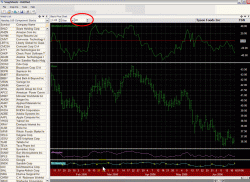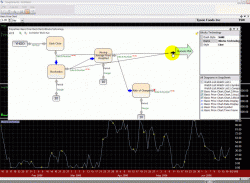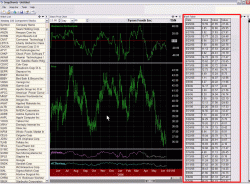Search Results for 'traders'
Worden SnapSheets – A Look at the Future
Back in early February of this year, I was fortunate enough to be invited to be part of a focus group for a brand new product Worden is about to roll out – SnapSheets. There were about two dozen of us there and we were the very first ones to get to see this incredible technology which has been under development for the last few years. I had no problem signing a confidentiality agreement in exchange for a shot at getting a Beta version of SnapSheets installed on my laptop. Although it’s been difficult, I did remain silent until now (I finally got permission!).
Originally called Blocks, SnapSheets integrates seamlessly with the new TeleChart 2007. SnapSheets is free for TeleChart users and gives you data analysis capabilities that exceed what you will find in professional platforms costing thousands. SnapSheets is going to revolutionize the way stock chartists and researchers tinker with data, because it allows the user to combine data sources all in one place – on the code level.
SnapSheets can be run as an add-on/companion product to TC2007 or you can run it standalone. Here are some of the types of things you can do with SnapSheets & TC2007:
– Create your own custom market indexes & indicators for any WatchList
– Tie your active symbol to Internet browsers as you “spacebar” through your charts
– Access many new tools including point & figure, swing charts, million-dollar bar, monthly cycles, tables & much more
– Create your own conditional “true markers” on your charts
– Count any condition historically with ridiculous speed
– Plot an indicator of any indicator – there’s no limit to daisy-chaining or mixing of data
– Display the distribution of stocks in a WatchList using pie charts
– Plot technical indicators of TeleChart’s fundamental criteria (requires optional historical data feed)
– Write your own indicators (1000 times more powerful than PCF’s)
– Save custom-layout SnapSheets of any number of charts, tables and tools
– Use data from any source and display it in any way you want, with “on the fly” calculations of anything you wish to create
Like I said, the possibilities are truly limitless and this product is going to be the solution to the needs of so many traders. Developers can even create their own “Blocks” using any .NET programming language.
Here are a few screenshots of TeleChart 2007 & SnapSheets:
 SnapSheets allows you to add a ‘spinner’ to your charts for any indicator you want to change with just the click of an arrow or by entering a value. Want your moving average to be a 100-period average instead of a 9-period average? Use the spinner and it is instantly changed.
SnapSheets allows you to add a ‘spinner’ to your charts for any indicator you want to change with just the click of an arrow or by entering a value. Want your moving average to be a 100-period average instead of a 9-period average? Use the spinner and it is instantly changed. SnapSheets can be changed right on the code level, and these “Blocks” can be pointed to send or receive data to any other source, making this the most versatile product available.
SnapSheets can be changed right on the code level, and these “Blocks” can be pointed to send or receive data to any other source, making this the most versatile product available.During the meeting I attended in Ft. Lauderdale back in February, Worden President Chris Worden and a few of Worden’s top programmers walked us through some examples of what SnapSheets is capable of and ways we could use it. We would suggest a bizzare calculation we wanted to see run on something like the component WatchList of the Russell 2000, like how many stocks were above their 50-day moving average back on July 12th of 1998, and the program could instantly display the results in any form. Think about that – a calculation on a couple of thousands of stocks over the course of numerous years done INSTANTLY! Even more amazing, this was calculated for all historical dates, so we could scroll through time and instantly see the calculation for any given date. Absolutely incredible!
Worden will soon be rolling out TeleChart 2007 with the SnapSheets installation, so if you’re a subscriber be on the lookout for it. If you aren’t a subscriber, click the banner below!
Jeff White
President, The Stock Bandit, Inc.
www.TheStockBandit.com
[tags]Worden SnapSheets, Worden Blocks, TeleChart, TeleChart 2007, Stock Chart[/tags]
Worden’s TeleChart and TCNet
I’m a huge fan of Worden’s charting software, and I’ve been a user of it for 8 years. During that time, Worden’s product line has expanded and they’ve continually improved the product I started out with, TeleChart. I’ve tried products from other vendors and just haven’t found them to be any easier to use, more affordable, or better than what Worden offers. Worden strives to improve their software and service at all times, which is something I can definitely relate to! Worden also has something on the way which has the ability to do just about anything you’d ever want it to do – I know because I’ve been using it for several months. Needless to say, I’m not going anywhere!
So let’s take a look at some of the features of Worden’s charting program.
Worden’s basic charting package is called TeleChart 2005 or TeleChart Gold. It is $29/month and offers 20-minute delayed data, which is ideal for the end-of-day user or those who are swing trading based on daily charts. It comes with a host of canned features, such as:
– Entire stock market on your PC. You will literally have the entire market on your PC, with the ability to see every stock traded on the major US exchanges (bulletin board stocks or penny stocks not included). Every index is included too.
– Sectors. Seeing a stock on the move leaves traders like me looking for others in the same group which will move in sympathy. TeleChart allows you to see what sector a stock is in and then view all other stocks in the same industry or sub-industry.
– Component Watchlists. Ever wonder if a certain stock is in the Dow or S&P or NAZ 100? TeleChart keeps a current list of all stocks in these major indexes as well as many others, so the next time you’re wondering if that small-cap favorite is in the Russell 1000 Index, you’ll quickly be able to find out.
– Sorting. TeleChart allows you to sort by almost any criteria you can think of, right ‘out of the box.’ This is such a valuable feature, and the ability to sort a huge list of stocks with the click of a mouse is a tremendous time-saver. Among the limitless sorts are Volume, Beta, Capitalization, Float, Symbol, etc. The list goes on and on and you can even create your own.
TeleChart offers a host of charting possibilities as well:
Chart Templates. You can have unlimited chart templates, which are kind of like pages of charts which each have their own properties. Say you look at moving averages for trending stocks but you don’t want to see them otherwise – you could set up a chart template and with the push of one button instantly have those moving averages displayed. Maybe you sometimes look at candlesticks and other times you look at bar charts. Set up a different template and you can have them both anytime you want them.
Chart Customization. You can set up your charts to look however you want them. Make the bars or background whatever color you want. Add or remove gridlines. Add indicators (and custom indicators) to the chart window or down below, colored however you want them. Resize the charting area or indicator panes, or put indicators in panes above the prices.
Indicators. TeleChart comes pre-installed with just about any indicator you can think of. Whether you want moving averages, stochastics, Bollinger Bands, or almost anything else, it’s right there waiting for you to use it. You can even create and use your own.
EasyScans. EasyScans are appropriately named, as they’re a cinch to set up and they allow you to scan the entire market instantly for whatever you want. Let’s say you want to create a new watch list looking for all Nasdaq stocks which are above $5.00 but below $25.00 and have an average daily volume of 100,000 shares or greater. An EasyScan will let you do that and it will take you just a couple of clicks and you’ll have that list in seconds. Even better, once you have the list, you’ll be able to sort it by whatever criteria you want. It’s really amazing.
PCF’s. Personal Criteria Formula’s (PCF’s) are formulas which you write that add a new sort and scan criterion to the program. This is an advanced feature but a formula wizard can walk you through creating PCF’s. An example PCF would be if you wanted to be able to sort your stocks by something like “Price Percent Change last 50 Days.” This advanced feature has unlimited possibilities, which makes it a valuable function to many users.
TCNet. TCNet is the real-time version of TeleChart, also called TeleChart Platinum. TCNet is $99/month and provides real-time streaming charts, news, and live chat with other TCNet users. TCNet also offers alerts, which are an excellent feature if your trading platform doesn’t offer them. The alerts can be set for stocks you’re monitoring, and it can notify you via pop-up, email, or pager. The alerts are real-time, which is great in a fast-moving market compared to other providers of free alerts which are on a 20-minute delay.
Whether you go with Gold or Platinum, you’ll have the exact same charting program with either one, the main difference is real-time vs. delayed data. If your trading platform has a real-time data feed and you do your intraday charting with it, then the delayed TeleChart Gold should serve you well. However, if you want to be able to do all of your charting in one place and you want the alerts, news (including Briefing.com’s InPlay), live chat, and the ability to share your charts with other users, then TeleChart Platinum or TCNet is the one for you. It’s an amazing product and I won’t trade without it – I haven’t for 8 years now.
Take a free 30-day trial of TeleChart and check out what all it has to offer. I’m betting you won’t find anything that offers you an easy way to perform so many functions, especially at the price.
(By the way, Worden has a ton of help/tutorial videos on their site which will walk you through how to do virtually anything. Once you’re there, click the “Training” link at the top of the page.)
Jeff White
President, The Stock Bandit, Inc.
www.TheStockBandit.com
[tags]Trading Software, Stock Trading, Stock Market, Stock Chart[/tags]
How to Grow Your Trading Account, Part 2
 In Part 1, we discussed some general ideas about how to grow your trading account. Here in Part 2, let’s check out the impact of this concept.
In Part 1, we discussed some general ideas about how to grow your trading account. Here in Part 2, let’s check out the impact of this concept.
Jack and Jill are two hypothetical traders with different personal motives which lead to different plans for their trading profits. Keep in mind that both Jack and Jill have the same trading strategy.
Jack is a part-time trader looking to pull some money out of the market each year to supplement his income and help pay for his boat. Hypothetically, the same trading results will cap his earnings going forward, although it allows him some additional income each year. Every year, though, Jack’s account resembles these figures:
Jack: $100,000 trading account, withdrawing profits annually:
Beginning: $100,000.00
Profits: $20,000.00 (20% return)
Withdraw: $20,000.00
Ending: $100,000.00
Jill is a full-time trader who is performing the same as Jack each year, making 20%. Her husband works and they live off his income, which allows Jill to leave her trading account and subsequent profits intact. Jill begins to make more and more money every year with the same 20% performance. Look at the rapid growth Jill enjoys in her account:
Jill: $100,000 trading account, leaving profits intact:
Year 1 Beginning: $100,000.00
Profits: $20,000.00 (20% return)
Withdraw: $0.00
Ending: $120,000.00
Year 2 Beginning: $120,000.00
Profits: $24,000.00 (20% return)
Withdraw: $0.00
Ending: $144,000.00
Year 3 Beginning: $144,000.00
Profits: $28,800.00 (20% return)
Withdraw: $0.00
Ending: $172,800.00
Year 4 Beginning: $172,800.00
Profits: $34,560.00 (20% return)
Withdraw: $0.00
Ending: $207,360.00
WOW! Jill more than doubled her trading account in 4 years, whereas it will take Jack 5 years to double his initial stake. For Year 5, Jill would only need to make 9.7% to match Jack’s profit of $20,000! Or, she could match his 20% performance and more than double his profits for the year.
We all know the amazing results of compounding money, but hopefully this example of two hypothetical traders will get you thinking about what to do with your trading profits. If the freedom to access your trading profits each year is something you need, then regular withdrawals are for you. However, if you’ve got the savings put aside or an additional income to get you by, leaving your profits in your trading account even for a few years can do wonders for your trading results, even if your methodology never improves!
Jeff White
President, The Stock Bandit, Inc.
www.TheStockBandit.com
By the way, subscribing to this RSS feed will mean you won’t ever miss a post!
[tags]Trading Strategy, Stock Trading, Trading Account, Trading Profits[/tags]
How to Grow Your Trading Account, Part 1
 You and I may have different trading strategies and styles, but our goal is the same: extract profits from the market. I love trading, and I hope to continue doing it one way or another for many years to come, no matter how large I can grow my account.
You and I may have different trading strategies and styles, but our goal is the same: extract profits from the market. I love trading, and I hope to continue doing it one way or another for many years to come, no matter how large I can grow my account.
Account sizes vary from trader to trader, and not just due to different financial situations. Some traders sweep excess funds at the end of the month out of their trading account, while others leave the majority of their money in their trading account feeling like it’s the best place for it.
Better trading means a bigger account, right?
Isn’t a growing account the result of making profitable trades? Well, yes and no. It is not necessarily the same as just making money trading. After all, you can be a profitable trader and as long as you are withdrawing the profits from your account it won’t get any fatter! Growing your account is the result of profitable trades, yes, but also results from a decision on your part to commit to leaving those profits alone.
Why trade a larger account?
Trading a larger account has numerous benefits if you’re a disciplined trader:
* Your buying power increases exponentially.
* The same trading performance which led your account to the current levels will mean even greater profits going forward.
* Your money will have the ability to compound, getting you ever closer to those financial goals of yours.
* Making the same income you’ve come to expect from your trading will mean you won’t have to achieve the same percentage returns. In essence, it becomes easier to make the same money, because you can be a more selective trader and only participate when the market acts like you want it to.
Is bigger always better?
When it comes to your trading account, that’s a question only you can answer. Speaking generally, a trader with poor discipline needs the smallest trading account possible so that he can do the least amount of damage! The remaining traders who aren’t willing to risk blowing out their accounts can see the benefits shown above. Some trading styles are naturally more capital-intensive (pairs trading) or less capital-intensive (scalping one trade at a time). If your style isn’t one which requires a great deal of buying power, then you might want to pay off the house or cars with that excess capital and buy yourself some financial freedom in the future.
So how do you grow a trading account?
Good trading is the short answer, but there’s a longer answer if you want it. The decision to leave your profits in your account is an important one. Having a secondary income from another job or your spouse can help minimize the initial impact of leaving your profits intact. Having a savings or checking account big enough to get you through several months can also make it easier. By making the commitment to retain profits in your account, you’ll soon see that your current level of performance is going to mean even bigger profits going forward. In Part 2, we’ll take a look at a pair of hypothetical traders in different situations with different plans for their profits.
Jeff White
President, The Stock Bandit, Inc.
www.TheStockBandit.com
[tags]Stock Trading, Trading Account, Trading Profits[/tags]
By the way, subscribing to this RSS feed will mean you won’t ever miss a post!
Why Upside Has Been Limited
Lately we’ve seen occasional bounces with flashes of brilliance (like the June 15th rally which was the best one-day point gain for both the NAZ and S&P 500 since March 2003), but the upside has been significantly limited. Since the major indexes started trending lower back in May, the upside we’ve seen has merely been the flash-in-the-pan type. Why is that so often the case during bear markets?
Consider the speed of the 2 recent market declines. They were both downdrafts where the selling was heavy and constant with no real breather on the way down. Both selloffs came with streaks of 8 consecutive down sessions for the NAZ (5/9 thru 5/18, and 6/2 thru 6/13). Combine these ugly selloffs with the fact that so many participants in the market can’t seem to take a loss no matter when they occur (they aren’t disciplined traders who know when to sell stocks!), and you get the ingredients for persistent pain.
Get A Grip!
How’s your grip on your emotional swings in trading? Are you able to narrow your focus when things start to go your way? Are you able to walk away (if even for a short time) when you recognize that you’re making mistakes? If a fly on the wall were to observe you during the day or during the week, what would he see when it comes to your self-control over your emotions?
Making and losing money (trading) inevitably stirs up some emotions within us. Whether it’s the pain and frustration of a losing trade stopping you out, the excitement of money flowing into your account by way of that trade you just nailed, or the uncertainty of that new position you just entered, trading can easily put logic on the backburner if you let it.
Great Equipment Won’t Make You Great
Every year in the golf world, newer and better equipment is revealed to make the game easier to play. Sweet spots get bigger, clubs get lighter, the ball goes farther. The problem is that the equipment only improves the results of the player incrementally – it doesn’t give them a great skill. That part they have to “dig out of the ground”, as Ben Hogan said. Trading is similar in that each year, new software and faster PC’s are produced which have the allure of quick and easy profits to the trader willing to purchase them. The fact is, traders are still limited to their own skill levels regardless of if they have the fastest computer or internet connection or trading platform. A 20-handicap golfer will probably only be able to hit that one perfect drive about once a round, so spending $400 on the newest oversize driver to replace last year’s model won’t show him the improvement he’s looking for. He’s far better off spending that same money on something that will improve his process, like taking some lessons or paying for range balls to hit while he tries to groove his swing better. Once he’s able to play more consistently, he’ll be far more capable of seeing a difference with better equipment. Traders can relate to this and avoid paying up for products with every possible bell and whistle available if they lack the discipline to trade consistently to begin with. Upgrade your method first, your equipment later. Odds are it isn’t the equipment causing you trading trouble.
Jeff White
President, The Stock Bandit, Inc.
www.TheStockBandit.com
[tags]Golf, Golf Equipment, Ben Hogan, Trading Psychology[/tags]
By the way, subscribing to this RSS feed will mean you won’t ever miss a post!








